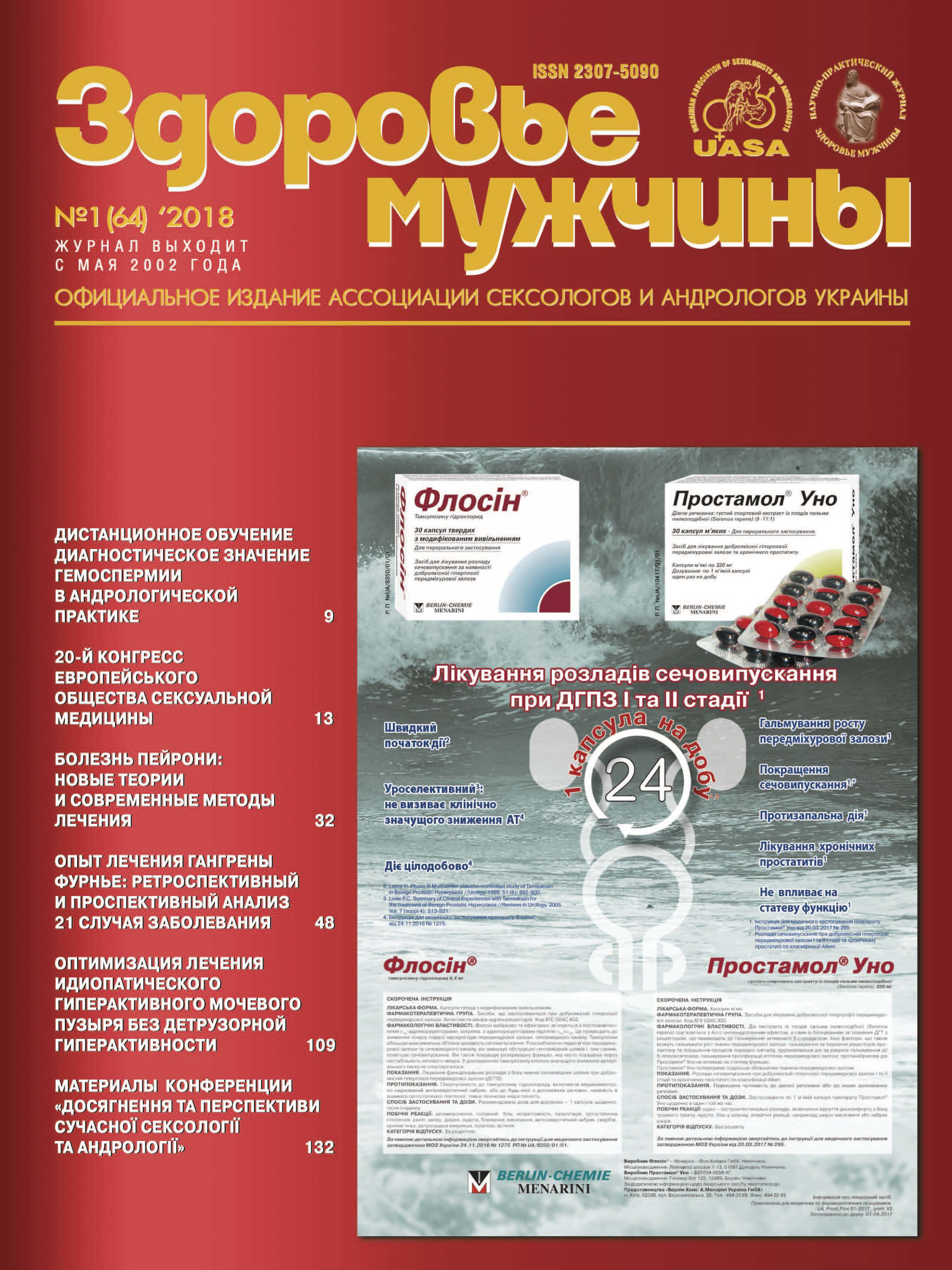Оцінювання ефективності терапії ідіопатичного гіперактивного сечового міхура із застосуванням методів біологічного зворотного зв’язку
##plugins.themes.bootstrap3.article.main##
Анотація
Мета дослідження: оцінювання змін показників електроміографії (ЕМГ) у жінок з гіперактивним сечовим міхуром (ГАСМ), вивчення можливості корекції адаптаційних можливостей сечового міхура методом біологічного зворотного зв’язку (БЗЗ) у поєднанні з ETS (ЕМГ-тригерна електростимуляція) м’язів тазового дна.
Матеріали та методи. Обстежено 73 жінок із симптомами ГАСМ. На підставі даних уродинамічного дослідження пацієнток розподілили на групи: І група (n=34) – хворі з детрузорною гіперактивністю; ІІ група (n=39) – хворі з ГАСМ без детрузорної гіперактивності.
Результати. Дослідженням ЕМГ симптоми дисфункції посмугованих м’язів промежини і сфінктерного апарату тазових органів були встановлені у 78,2% жінок з ургентною формою нетримання сечі. У жінок із «сенсорними» симптомами ГАСМ без інконтиненції дисфункції м’язів промежини і сфінктерного апарату були встановлені у 36,8% та у 53,4% хворих на ГАСМ з алгічним синдромом.
Заключення. При застосуванні методу БЗЗ у поєднанні з ETS показники м’язової роботи тазових сфінктерів покращилися вже через 2 тиж у 52% хворих, через 4 тиж показники ЕМГ покращилися у 61% хворих, а до 15-го заняття прогрес в якості м’язової роботи зафіксований у 68% хворих.##plugins.themes.bootstrap3.article.details##

Ця робота ліцензується відповідно до Creative Commons Attribution 4.0 International License.
Автори зберігають авторське право, а також надають журналу право першого опублікування оригінальних наукових статей на умовах ліцензії Creative Commons Attribution 4.0 International License, що дозволяє іншим розповсюджувати роботу з визнанням авторства твору та першої публікації в цьому журналі.
Посилання
Buckley BS, Lapitan MC, Epidemiology Committee of the Fourth International Consultation on Incontinence, Paris, 2008. Prevalence of urinary incontinence in men, women, and children-current evidence: findings of the Fourth International Consultation on Incontinence. Urology 2010; 76:265. https://doi.org/10.1016/j.urology.2009.11.078
Management Recommendations. In: Incontinence, 4th ed., Abrams P, Cardozo L, Khoury S, Wein A. (Eds), Health Publications, Paris 2009. – p. 1774.
Diagnosis and treatment of overactive bladder (non-neurogenic) in adults: AUA/SUFU Guideline / E.A. Gormley, D.J. Lightner, K.L. Burgio [et al.] // 2012 May. American Urological Association. https://doi.org/10.1016/j.juro.2012.09.079
Tikkinen K.A. Does the Imprecise Definition of Overactive Bladder Serve Commercial Rather than Patient Interests? / K.A. Tikkinen, A. Auvinen // Eur Urol. – 2012 Apr;61(4):746–8; discussion 749–50. Epub 2012 Jan 5. https://doi.org/10.1016/j.eururo.2011.12.013
DuBeau CE. Treatment of urinary incontinence. In: UpToDate. Basow DS (Ed), UpToDate, Waltham, MA, 2012.
Benefits and harms of pharmacologic treatment for urinary incontinence in women: A systematic review / T. Shamliyan, J.F. Wyman, R. Ramakrishnan [et al.] // Ann Intern Med. 2012 Jun 19;156(12):861–874. https://doi.org/10.7326/0003-4819-156-12-201206190-00436
EAU guidelines on urinary incontinence / J.A. Thüroff, P. Abrams, K.E. Andersson [et al.] // Eur. Urol. – 2011 Mar; 59(3):387–400. https://doi.org/10.1016/j.eururo.2010.11.021





